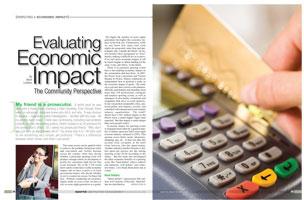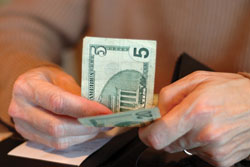
My friend is a prosecutor. A while back he was assigned a tragic case involving a fatal shooting. Even though there were no witnesses, everyone knew who did it, and why. It was obvious to anyone - neighbors, police investigators - familiar with the case. Yet no arrests were made. There was controversy, including loud protests outside city hall demanding justice, which created a lot of pressure for the prosecutor's office. So I asked my prosecutor/friend, "Why don't you just lock up the guy who did it? You know who it is." He then said to me something very simple, yet profound: "There's a difference between what I know, and what I can prove."
 That same axiom can be applied when it comes to the problem facing host cities and convention and visitors bureaus across the country when they decide whether a particular sporting event will produce enough return on investment to justify the sometimes high bid fee that event demands. We in the CVB world know sports events have a solid economic impact, but we have to prove it to local government leaders who decide whether to commit tax money for those bid fees. Without conducting an economic impact study on every event, we have to rely on room night generation as a guide.
That same axiom can be applied when it comes to the problem facing host cities and convention and visitors bureaus across the country when they decide whether a particular sporting event will produce enough return on investment to justify the sometimes high bid fee that event demands. We in the CVB world know sports events have a solid economic impact, but we have to prove it to local government leaders who decide whether to commit tax money for those bid fees. Without conducting an economic impact study on every event, we have to rely on room night generation as a guide.
The higher the number of room nights generated, the higher the economic impact on the host city. Furthermore, while we may know how many total room nights are generated, some fans and participants stay "outside the block" (in hotels besides those designated as "host" hotels), making it difficult for us to prove. If we can't prove economic impact, it will be much tougher to obtain funding for the same event, and others, in the future.
There is no question sporting events have a far-reaching economic impact on the communities that host them. In 2007, the Peoria Area Convention and Visitors Bureau in Peoria, Illinois contracted an independent firm to perform a study on the economic impact of sports. The study surveyed and interviewed event planners, officials, participants and attendees from more than 250 professional, collegiate and amateur sporting events, as well as managers of area hotels, restaurants, and companies that serve as event sponsors. It also researched comparable cities, analyzed public and industry records, and consulted with national travel and tourism industry organizations. The result? Sports have a $61 million impact on the Peoria Area, a much higher figure than expected. But that impact is much deeper than most people realize.
Economic impact for sporting events is measured most often by a general number of dollars spent per hotel room night (current industry standard is $299). That amount covers hotel, meals, attractions, shopping, gas, etc. It does not take into account extra occupants in the hotel room, however, who also spend money. Another industry number formula is dollars spent per person, per day during sporting events ($146 according to the study). But this study also investigated the other economic benefits of a sporting event, like "hard dollars" (direct, indirect and induced), "soft dollars" and volunteer hours. Let's break them down one at a time.
Hard Dollars
"Hard dollars" represented $40 million,or 67%, of the total. Hard dollars are described as all direct, indirect and induced spending. Direct spending represents the purchases made to meet the demand of visitors for goods and services. For instance, ballparks stock up on hot dogs, soda and programs before each game. But those core costs will be covered, plus enough for taxes and profit, once the goods are sold to visitors. Indirect spending is the ripple effect, or second round of spending - the recirculation of visitors' dollars. For instance, the ballpark will need to hire workers to sell the hot dogs, soda and programs. This not only creates and sustains jobs it also creates the opportunity for employees to increase their income through working more hours and/or landing a better-paying job. Induced spending is the increase in employment and household income that results from the economic activity fueled by the direct and indirect spending. For instance,those workers take their wages they earned from selling hot dogs, soda and programs at the ballpark and use part of that income to buy dinner at a local restaurant.
 Consider this example from the study: An event promoter rents 10 inflatable attractions to assist in the promotion of his event. He spends $500 with the local rental company (direct spending). The rental company then uses a portion of that $500 to hire workers to set-up, staff and tear down the equipment (indirect spending). The employees then spend some of their earnings at the local grocery store(induced spending). But it doesn't stop there. The grocery store uses a portion of that money to pay the cashier, the cashier spends part of her earnings derived from that money at a local restaurant, and the cycle continues...
Consider this example from the study: An event promoter rents 10 inflatable attractions to assist in the promotion of his event. He spends $500 with the local rental company (direct spending). The rental company then uses a portion of that $500 to hire workers to set-up, staff and tear down the equipment (indirect spending). The employees then spend some of their earnings at the local grocery store(induced spending). But it doesn't stop there. The grocery store uses a portion of that money to pay the cashier, the cashier spends part of her earnings derived from that money at a local restaurant, and the cycle continues...
Soft Dollars
"Soft dollars" represent the cash value of in-kind goods and services that are required to conduct a particular event. For instance if an outdoor event requires portable outdoor restrooms, and a local vendor donates them, the amount the event organizer would have had to pay in cash to rent the restrooms represents "soft dollars." Media advertising, while helpful for promotion, is not required to put on the event. Therefore advertising "trades"would not qualify as soft dollars.
Volunteer Hours
Volunteer hours are worthy of measuring because without volunteerism events would be much more costly. Think about it: What if you had to hire and pay more staff to perform the same labor as volunteers? That's a budget-buster for many events.
But to steal from the Visa credit card commercials, the value of increased visibility and image enhancement for the host city that the event creates is priceless. The best marketing tool on the planet is word of mouth. If a sporting event is successful in a particular host city, then the attendees, participants, officials and organizers will speak highly of that city for some time to come. What is that worth?
All of the information provided in the study is insightful, makes sense, and confirms what we already knew: sports play in Peoria. But here's the dirty little secret: it is pretty difficult to convince an elected official to commit tens of thousands of taxpayer dollars for a sporting event bid fee and point to this study as proof there will be a high economic impact. As a CVB President/CEO, I get the fun job of getting grilled by City Councils, County Boards, committees and civic leaders who demand to know what kind of return on investment they're getting for the funding our organization receives. As elected leaders, they have to justify to the taxpayers that tax money is being invested wisely. So when we decide whether to host an event, there is a list of criteria we consider, and it's based only on what we can prove:
1) Room night generation. The simplest, yet most important tool to gage economic impact. Regardless what formula or multiplier you use, common sense dictates the more room nights you produce, the more money that gets pumped into the area. Similarly, is this a multi-day event? Las Vegas knows better than anyone the longer you keep visitors in your town, the more money they are going to spend in your town. Attendance is nice, and based on the information from Peoria's economic impact study, a good number to know and share with the potential host city. But it's difficult for Mrs. Restaurant Owner to know how her eatery will be impacted because she doesn't know how many customers she'll get. Similarly, Mr. Gas Station Owner doesn't know how many people are flying or driving, and whether the driving crowd will use his place to fill up. And Mrs. Retail Business Owner has no idea how many people will shop at her store. So, follow the old economic adage, "Keep it simple."
2) Proven track record. Where has this event been before, and what kind of numbers did it produce there? How was the room night "block" (the number of room nights requested be set aside for the event) versus the room night "pick-up" (the actual number of rooms that were rented)? For instance, does the event have a reputation of requesting 1,000 rooms but only filling 500 of them?
3) Repeat business. Does this have the potential to come back in future years, or is it a one-time event? Repeat business is the bread and butter of any venue.
4) Additional business. Could this event lead to larger business or other related events? For example, a successful state event might lure the regional event, then the national, etc. Or, if the event is successful, the host city then becomes an attractive option to other organizations within the same sport.
5) Publicity. Will this event provide regional or national exposure for the host city through the media - television, radio, magazines, websites, ads, etc.?
6) Type of event. Will the attendees and participants have "down time" to spend eating at restaurants, shopping, and visiting amusements/attractions, or will there be very little time to leave the venue? Restaurants, shops and attractions aren't impressed by high attendance figures if everyone stays inside the sports venue during the whole event and eats at the concession stands.
 Success, for both parties, is an integral component of the criteria. We use a simple, two-part formula to determine whether an event was successful:
Success, for both parties, is an integral component of the criteria. We use a simple, two-part formula to determine whether an event was successful:
a) Were the event organizers pleased? In other words, were the participants, fans, officials, vendors and organization executives happy with the venue, hotels, restaurants, attractions, shops, amenities and general appeal of the city? Did they all have a good experience? Was service outstanding? Did the event achieve its goals - attendance, ticket sales, etc.? Would they consider our city again as a host?
b) Did enough room nights pick up? Did we get a solid return on investment?
So, as you plan your next event, help the host city develop methods to prove room night generation. Some sports organizations require participants to list their hotel on their registration forms. If that information is missing, the athlete is not allowed to compete. If coaches are paying for multiple rooms they have to identify which athletes are staying in each of those rooms. Also, communicate to your fan base how important it is to let the hotel know at check-in what group they're with - typically that should get them the best room rate available. If anyone from your group gets a better deal by staying outside the block, communicate that to the CVB so the problem can be addressed. And be honest. Don't spin, pad or exaggerate your numbers. Be ready to show a legitimate history of the room nights that were generated in each of the cities that have hosted your event before - don't make the CVB dig for them. Being upfront and proactive will go a long way toward building a positive relationship. We're going to discover those numbers anyway; we in the CVB industry look out for each other, because we've all been burned before on promises of huge turnouts that never materialized. Finally, trust that we both want the same thing - a successful event for you and the host city.
Remember, we both know your event will be an economic boon. Peoria's economic impact study shows us that. But it's not what we know; it's what we can prove.

